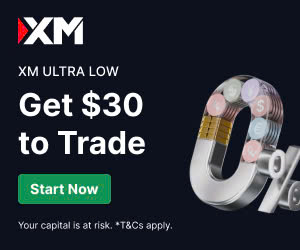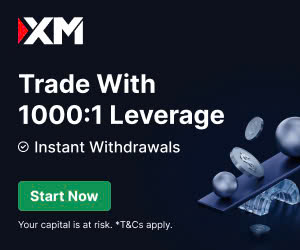
10 minute read
XM vs Roboforex: A Comprehensive Comparison
Choosing the right forex broker is a critical decision for traders, whether you're a beginner or a seasoned professional. Two well-known names in the industry, XM vs RoboForex, consistently attract attention due to their competitive offerings, robust platforms, and global reach. In this in-depth comparison, we’ll explore XM vs RoboForex across key criteria such as regulation, account types, trading platforms, fees, trading instruments, customer support, and educational resources. By the end, you’ll have a clear understanding of which broker aligns best with your trading goals.

💥 Trade with XM now: Open An Account or Visit Brokers 🏆
Overview of XM vs RoboForex
XM
Founded in 2009, XM is a globally recognized forex and CFD broker headquartered in Cyprus. It serves over 3.5 million traders across 190 countries, offering access to more than 1,000 trading instruments. XM is known for its user-friendly platforms, low minimum deposits, and strong focus on customer support and education. The broker is regulated by multiple authorities, including the Cyprus Securities and Exchange Commission (CySEC), the Australian Securities and Investments Commission (ASIC), and the Financial Services Commission (FSC) in Belize.
RoboForex
Also established in 2009, RoboForex is based in Belize and has built a reputation for its diverse range of trading instruments and flexible account types. With over 12,000 markets available, RoboForex caters to traders looking for variety, from forex to cryptocurrencies and stocks. The broker is regulated by the International Financial Services Commission (IFSC) in Belize and is a member of The Financial Commission, offering additional investor protection.
Regulation and Safety
XM
XM’s regulatory framework is one of its strongest selling points. The broker operates under multiple licenses from reputable authorities:
· CySEC (Cyprus): Ensures compliance with EU regulations, including segregated client funds and negative balance protection.
· ASIC (Australia): A top-tier regulator known for stringent oversight.
· FSC (Belize): Provides flexibility for global clients.
· DFSA (Dubai) and FSCA (South Africa): Additional licenses for regional operations.
These licenses enhance XM’s credibility, ensuring client funds are held in segregated accounts and protected up to a certain amount in case of insolvency (e.g., €20,000 under CySEC). XM also emphasizes transparency, with no hidden fees and clear terms for withdrawals and trading conditions.
RoboForex
RoboForex is primarily regulated by the IFSC in Belize, which is considered less stringent than CySEC or ASIC. However, the broker is a member of The Financial Commission, which provides a compensation fund of up to €20,000 per client in case of disputes. RoboForex also offers negative balance protection and segregates client funds, but its regulatory oversight is less robust compared to XM due to the single jurisdiction.
Verdict: XM has a slight edge in regulation due to its multiple licenses from top-tier authorities, offering greater peace of mind for traders prioritizing safety.
Account Types
XM
XM offers four main account types, catering to different trading styles and experience levels:
· Micro Account: Ideal for beginners, with a $5 minimum deposit and micro-lot trading (0.01 lots).
· Standard Account: Similar to the Micro Account but with standard lot sizes, also requiring a $5 minimum deposit.
· Ultra Low Account: Designed for cost-conscious traders, offering spreads as low as 0.6 pips but with a $50 minimum deposit.
· Shares Account: For trading real shares, with a higher minimum deposit of $10,000.
All accounts support Islamic (swap-free) options, and XM provides a demo account for practice. The low minimum deposits make XM accessible to new traders.
RoboForex
RoboForex offers a broader range of account types, providing flexibility for various strategies:
· Pro-Standard: A versatile account with a $10 minimum deposit and floating spreads.
· Pro-Cent: Allows trading with micro-lots, also with a $10 minimum deposit.
· ECN Account: Offers tight spreads and low commissions, with a $10 minimum deposit.
· Prime Account: An advanced ECN account with lower commissions, requiring a $10 minimum deposit.
· R StocksTrader: A proprietary platform for trading over 12,000 instruments, with a $100 minimum deposit.
RoboForex also supports Islamic accounts, CopyFX for copy trading, and RAMM for strategy copying. Like XM, it offers a demo account.
Verdict: RoboForex provides more account variety, particularly for advanced traders interested in ECN or stock trading. XM, however, is more beginner-friendly due to its lower minimum deposits and simpler account structure.
Trading Platforms
XM
XM supports two of the most popular trading platforms:
· MetaTrader 4 (MT4): Known for its reliability, advanced charting, and support for Expert Advisors (EAs).
· MetaTrader 5 (MT5): An upgraded version with additional features like more timeframes, hedging, and access to stocks and cryptocurrencies.
Both platforms are available on desktop, web, and mobile devices, ensuring seamless trading across devices. XM’s platforms are user-friendly and equipped with tools like one-click trading, pending orders, and customizable indicators.
RoboForex
RoboForex offers a wider selection of platforms:
· MetaTrader 4 and MetaTrader 5: Similar to XM, with full support for EAs, hedging, and scalping.
· cTrader: A platform favored by ECN traders for its fast execution and advanced charting.
· R StocksTrader: A proprietary web-based platform designed for trading stocks, ETFs, and other instruments, with a strategy builder for creating trading robots.
· WebTrader and Mobile Apps: For on-the-go trading.
RoboForex’s variety of platforms caters to different trading preferences, from traditional forex to stock trading.
Verdict: RoboForex wins for platform diversity, offering cTrader and R StocksTrader in addition to MT4/MT5. XM’s focus on MT4 and MT5 is sufficient for most traders but lacks the additional options provided by RoboForex.
Fees and Spreads
XM
XM is known for its competitive fee structure:
· Spreads: Variable spreads start at 1 pip on Standard and Micro accounts, 0.6 pips on Ultra Low accounts, and 0.1 pips on XM Zero accounts (with commissions).
· Commissions: Only the XM Zero account charges a commission ($3.5 per lot per side).
· Non-trading fees: No deposit or withdrawal fees, but an inactivity fee of $5 per month applies after 90 days of no activity.
XM’s Ultra Low account is particularly appealing for traders seeking low spreads without commissions.
RoboForex
RoboForex also offers competitive pricing:
· Spreads: Floating spreads start at 1.3 pips on Pro-Standard accounts, 0.0 pips on ECN and Prime accounts.
· Commissions: ECN accounts charge $2–$4 per lot, while Prime accounts have lower commissions.
· Non-trading fees: No deposit or withdrawal fees, and no inactivity fees, which is a significant advantage.
RoboForex’s ECN and Prime accounts are ideal for scalpers and high-frequency traders due to their tight spreads and low commissions.
Verdict: RoboForex has a slight edge due to its lower spreads on ECN accounts and no inactivity fees. However, XM’s Ultra Low account offers a good balance for traders avoiding commissions.

💥 Trade with XM now: Open An Account or Visit Brokers 🏆
Trading Instruments
XM
XM offers over 1,000 instruments across multiple asset classes:
· Forex: 60+ currency pairs.
· Commodities: Gold, silver, oil, and soft commodities.
· Indices: Major global indices like US30, DAX, and FTSE.
· Stocks: Over 1,000 stock CFDs on MT5.
· Cryptocurrencies: Limited to major coins like Bitcoin and Ethereum.
· Energies and Metals: Including natural gas and palladium.
XM’s MT5 platform provides the broadest range of instruments, while MT4 is more limited (e.g., no stock CFDs).
RoboForex
RoboForex boasts an impressive 12,000+ instruments:
· Forex: 45+ currency pairs.
· Commodities: Gold, silver, oil, and agricultural products.
· Indices: Global indices like S&P 500 and Nikkei.
· Stocks: Over 12,000 stock CFDs via R StocksTrader.
· Cryptocurrencies: 20+ coins, including Bitcoin, Ethereum, Ripple, and Dogecoin.
· ETFs: Available on R StocksTrader.
RoboForex’s R StocksTrader platform is a standout for stock and ETF trading, offering significantly more options than XM.
Verdict: RoboForex dominates in instrument variety, particularly for stock and cryptocurrency traders. XM’s offering is robust but falls short of RoboForex’s extensive range.
Customer Support
XM
XM is renowned for its exceptional customer support:
· Availability: 24/5 via live chat, email, phone, and social media.
· Languages: Support in over 30 languages, catering to its global clientele.
· Response Time: Quick and efficient, with live chat responses often within minutes.
· Personal Account Managers: Available for personalized assistance.
XM’s focus on customer care makes it a favorite among traders who value accessibility.
RoboForex
RoboForex also provides solid customer support:
· Availability: 24/7 via live chat, email, and phone.
· Languages: Multiple languages supported, though fewer than XM.
· Response Time: Generally fast, with live chat being the most responsive channel.
· Additional Tools: An economic calendar and market analysis enhance the support experience.
RoboForex’s 24/7 availability is a plus, but its support is less multilingual compared to XM.
Verdict: XM edges out RoboForex due to its multilingual support and personalized account managers, though RoboForex’s 24/7 availability is a strong point.
Educational Resources
XM
XM excels in educational offerings, particularly for beginners:
· Webinars: Regular sessions on forex trading, technical analysis, and market strategies.
· Video Tutorials: Covering platform usage, trading basics, and advanced techniques.
· Forex Signals: Daily signals for premium account holders.
· Market Analysis: Daily technical analysis and market outlooks.
· Economic Calendar: Keeps traders informed of key events.
XM’s resources are comprehensive and accessible, making it ideal for new traders.
RoboForex
RoboForex provides a decent range of educational tools:
· Webinars: Focused on trading strategies and platform features.
· Video Tutorials: Covering MT4, MT5, and R StocksTrader.
· Market Analysis: Regular updates and an economic calendar.
· Strategy Builder: A unique tool for creating trading robots without coding.
While RoboForex’s resources are valuable, they are less extensive than XM’s.
Verdict: XM is the clear winner for educational resources, offering a wider range of materials tailored to beginners and advanced traders alike.
Pros and Cons
XM
Pros:
· Regulated by multiple top-tier authorities (CySEC, ASIC).
· Low minimum deposit ($5 for most accounts).
· Competitive spreads, especially on Ultra Low accounts.
· Excellent customer support with multilingual options.
· Comprehensive educational resources.
Cons:
· Fewer trading instruments compared to RoboForex.
· Inactivity fees after 90 days.
· Limited cryptocurrency offerings.
RoboForex
Pros:
· Extensive range of over 12,000 trading instruments.
· Diverse account types, including ECN and Prime accounts.
· Multiple platforms, including cTrader and R StocksTrader.
· No inactivity fees.
· 24/7 customer support.
Cons:
· Regulated only by IFSC, which is less stringent.
· Higher minimum deposit for R StocksTrader ($100).
· Less comprehensive educational resources.
Which Broker Is Right for You?
Choosing between XM vs RoboForex depends on your trading priorities:
· For Beginners: XM is the better choice due to its low minimum deposits, user-friendly platforms, and extensive educational resources. Its strong regulatory framework also provides added security for new traders.
· For Advanced Traders: RoboForex is more suitable for experienced traders seeking a wider range of instruments, advanced platforms like cTrader, and low-cost ECN accounts for high-frequency trading.
· For Stock and Crypto Traders: RoboForex’s R StocksTrader platform and 12,000+ instruments make it the go-to option for those focused on stocks, ETFs, and cryptocurrencies.
· For Safety-Conscious Traders: XM’s multiple top-tier licenses (CySEC, ASIC) offer greater peace of mind compared to RoboForex’s single IFSC regulation.
Conclusion
Both XM vs RoboForex are reputable brokers with unique strengths. XM stands out for its regulatory oversight, beginner-friendly features, and exceptional customer support, making it ideal for new traders or those prioritizing safety. RoboForex, on the other hand, excels in instrument variety, platform diversity, and advanced trading options, appealing to experienced traders seeking flexibility.
Ultimately, the best broker depends on your trading style, experience level, and priorities. We recommend testing both brokers with demo accounts to evaluate their platforms and conditions firsthand. Whichever you choose, both XM vs RoboForex offer reliable environments for forex and CFD trading in 2025.
💥 Note: To enjoy the benefits of the partner code, such as trading fee rebates, you need to register with XM through this link: Open An Account or Visit Brokers 🏆
Read more:




